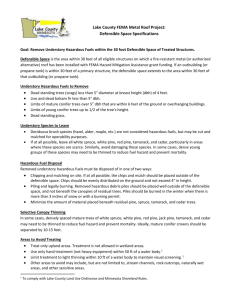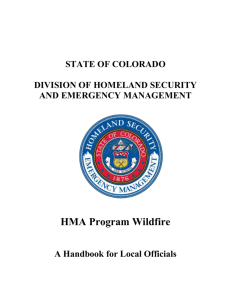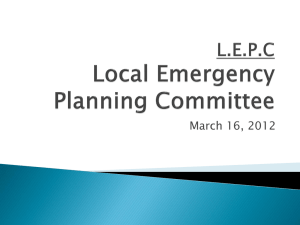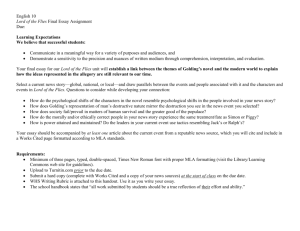metal roof maintenance and defensible space fuel reduction declarant
advertisement
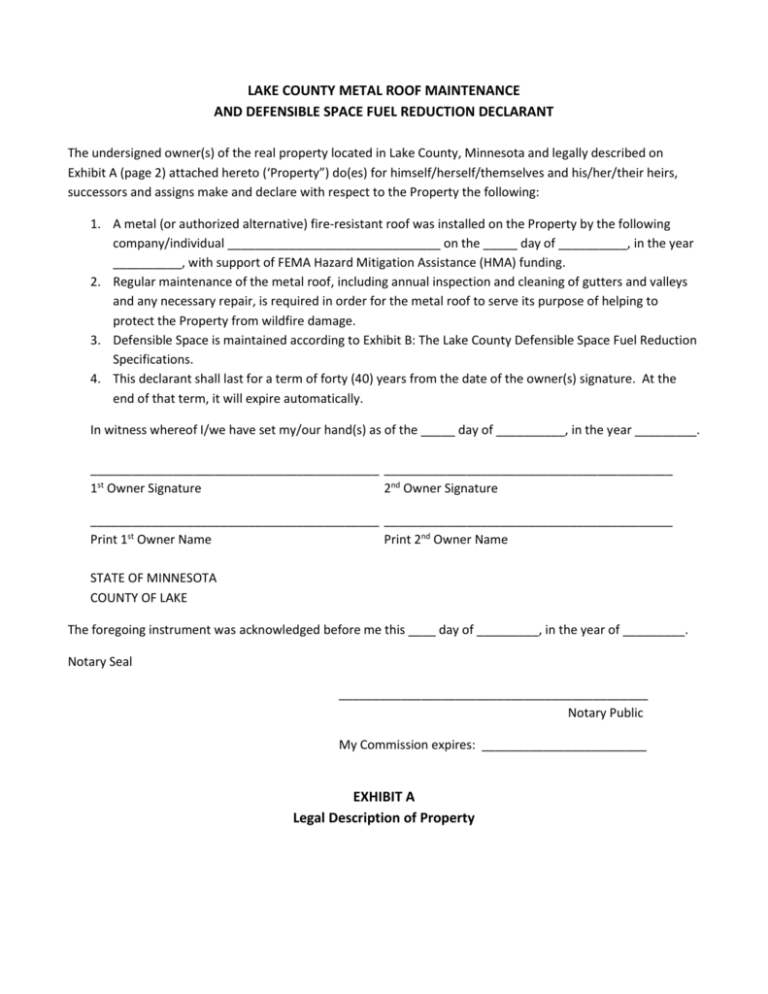
LAKE COUNTY METAL ROOF MAINTENANCE AND DEFENSIBLE SPACE FUEL REDUCTION DECLARANT The undersigned owner(s) of the real property located in Lake County, Minnesota and legally described on Exhibit A (page 2) attached hereto (‘Property”) do(es) for himself/herself/themselves and his/her/their heirs, successors and assigns make and declare with respect to the Property the following: 1. A metal (or authorized alternative) fire-resistant roof was installed on the Property by the following company/individual _______________________________ on the _____ day of __________, in the year __________, with support of FEMA Hazard Mitigation Assistance (HMA) funding. 2. Regular maintenance of the metal roof, including annual inspection and cleaning of gutters and valleys and any necessary repair, is required in order for the metal roof to serve its purpose of helping to protect the Property from wildfire damage. 3. Defensible Space is maintained according to Exhibit B: The Lake County Defensible Space Fuel Reduction Specifications. 4. This declarant shall last for a term of forty (40) years from the date of the owner(s) signature. At the end of that term, it will expire automatically. In witness whereof I/we have set my/our hand(s) as of the _____ day of __________, in the year _________. __________________________________________ __________________________________________ 1st Owner Signature 2nd Owner Signature __________________________________________ __________________________________________ Print 1st Owner Name Print 2nd Owner Name STATE OF MINNESOTA COUNTY OF LAKE The foregoing instrument was acknowledged before me this ____ day of _________, in the year of _________. Notary Seal _____________________________________________ Notary Public My Commission expires: ________________________ EXHIBIT A Legal Description of Property EXHIBIT B Lake County Defensible Space Fuel Reduction Specifications Goal: Remove Understory Hazardous Fuels within the 30 foot Defensible Space of Treated Structures. Defensible Space is the area within 30 feet of all eligible structures on which a fire-resistant metal (or authorized alternative) roof has been installed with FEMA Hazard Mitigation Assistance grant funding. If an outbuilding (or propane tank) is within 30 feet of a primary structure, the defensible space extends to the area within 30 feet of that outbuilding (or propane tank). Understory Hazardous Fuels to Remove Dead standing trees (snags) less than 5" diameter at breast height (dbh) of 4 feet. Live and dead balsam fir less than 5" dbh. Limbs of mature conifer trees over 5” dbh that are within 6 feet of the ground or overhanging buildings. Limbs of young conifer trees up to 1/2 of the tree's height. Dead standing grass. Understory Species to Leave Deciduous brush species (hazel, alder, maple, etc.) are not considered hazardous fuels, but may be cut and mulched for operability purposes. If at all possible, leave all white spruce, white pine, red pine, tamarack, and cedar, particularly in areas where these species are scarce. Similarly, avoid damaging these species. In some cases, dense young groups of these species may need to be thinned to reduce fuel hazard and prevent mortality. Hazardous Fuel Disposal Removed understory hazardous fuels must be disposed of in one of two ways: Chipping and mulching on site. If at all possible, the chips and mulch should be placed outside of the defensible space. Chips should be evenly distributed on the ground and not exceed 4" in height. Piling and legally burning. Removed hazardous debris piles should be placed well outside of the defensible space, and not beneath the canopies of residual trees. Piles should be burned in the winter when there is more than 3 inches of snow or with a burning permit. Minimize the amount of material placed beneath residual pine, spruce, tamarack, and cedar trees. Selective Canopy Thinning In some cases, densely spaced mature trees of white spruce, white pine, red pine, jack pine, tamarack, and cedar may need to be thinned to reduce fuel hazard and prevent mortality. Ideally, mature conifer crowns should be separated by 10-15 feet. Areas to Avoid Treating 1 Treat only upland areas. Treatment is not allowed in wetland areas. Use only hand treatment (not heavy equipment) within 50 ft of a water body.1 Limit treatment to light thinning within 10 ft of a water body to maintain visual screening. 1 Other areas to avoid may include, but are not limited to, stream channels, rock outcrops, naturally wet areas, and other sensitive areas. To comply with Lake County Land Use Ordinance and Minnesota Shoreland Rules.
